|

|
 |

Big Game Fishing
Magnificent and colorful coral reefs and the
clear blue waters of the Andaman Sea are a big draw to this island in
southern Thailand. Known worldwide for its swimming, sailing and diving,
Phuket has a secret. There is world-class game fishing ready and waiting
for the adventurous angler to enjoy.
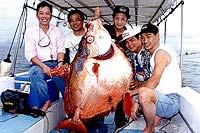 The
deep blue waters of the Andaman Sea are ideal for game fish and the
region is on the migratory paths of large numbers of Black Marlin, a classic
fighting fish. Late November is a good time to go after marlin, tuna and
any number of other fighting fish. By this time, the monsoons have settled
and the fish are biting. The best fishing is usually found around full
moon and spring moon and the drop-off west of Phuket and Similan Island
are the hot spots. The
deep blue waters of the Andaman Sea are ideal for game fish and the
region is on the migratory paths of large numbers of Black Marlin, a classic
fighting fish. Late November is a good time to go after marlin, tuna and
any number of other fighting fish. By this time, the monsoons have settled
and the fish are biting. The best fishing is usually found around full
moon and spring moon and the drop-off west of Phuket and Similan Island
are the hot spots.
Tuna are common and there are several varieties; Yellowfin, Dogtooth,
Skipjack, Mackerel, Longfin and Eastern Little Tuna. Wahoo are plentiful
during the monsoon season as well as Narrow Barred Mackerel (Tenggiri).
Sharks of several species can also be found. There are big  Tigersharks,
Bullsharks and Reef sharks. Other species of game fish include Dorado,
Rainbow Runner, Blue Finned Trevally, Cobia and a variety of bottom fish. Tigersharks,
Bullsharks and Reef sharks. Other species of game fish include Dorado,
Rainbow Runner, Blue Finned Trevally, Cobia and a variety of bottom fish.
Techniques for catching these fish are varied, they include: trolling
with artificials, dead baits and live baits, trolling with the downrigger,
casting poppers, jigging and spinning, drift fishing with live and dead
baits and bottom fishing. 
Biking and Running
One of the many advantages of biking or running
on Phuket are the many well-surfaced roads that wind through beautiful
green hills, rubber plantations and tropical rainforest. The scenic
road along the coastline from one white-sanded beach to another is a world-class
journey that should not be missed.
The wide variety of possibilities makes it easy to set a comfortable
pace, no matter whether you are on foot or on a bicycle. It just depends
on your athletic ability and your imagination. Many hotels and rental
facilities provide mountain bikes, on Phuket as well as on the neighboring
Krabi mainland.
There is a major sporting event for bikers and runners on Phuket,
that is a must-see: the Thai Airways Laguna Phuket Triathlon. It attracts
attention from all over the world and offers entries to the Ironman World
Championships in Hawaii. 
Rock Climbing
In the past few years, the area around Phang
Nga and the Krabi Province near Phuket, has become world renowned for
its climbing possibilities. High, sheer cliffs of limestone are there
to be challenged by the climber. Some reach a height of several hundred
meters, giving breathtaking views of the Thai landscape to those skilled
enough to reach the top.
In and around Krabi, there are many climbing schools offering instruction
for beginners and sports equipment for the more experienced climbers.

Horseback Riding and Riding Clubs
Phuket Island is definitely more famous for its
beaches, night life and golf, but for fans of horseback riding there
are several opportunities to enjoy horseback riding both at the beach
and in the woods.
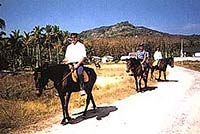 First
address for horseback riders would be the Phuket Laguna Riding Club, easily
to be spotted in front of the Dusit Laguna Hotel at First
address for horseback riders would be the Phuket Laguna Riding Club, easily
to be spotted in front of the Dusit Laguna Hotel at  Bang Tao Beach. For first-timers,
riding instructors are available. You can take your horse for a stroll
on the sand beach or saunter into the woods nearby. The best part is a
sunset ride along the beach - with the crimson sun in the background,
the sea breeze in your hair and the sound of the waves in your ears, maybe
the most romantic moment you could possibly have on Phuket.
Bang Tao Beach. For first-timers,
riding instructors are available. You can take your horse for a stroll
on the sand beach or saunter into the woods nearby. The best part is a
sunset ride along the beach - with the crimson sun in the background,
the sea breeze in your hair and the sound of the waves in your ears, maybe
the most romantic moment you could possibly have on Phuket.
The Phuket Riding Club is located near Rawai Beach in the southern part
of Phuket. It offers rides on imported quality horses from Australia on
peaceful Rawai Beach or the exploration of the woods and coconut plantations
around the club premises. Tour guides are available on request, and are
optional for skilled riders.
Best suited for family tours is the Crazy Horse Club near  Nai Harn Beach, providing
ponies for little children. From here you can also take your horse further
down onto nearby Laem Kanoi Beach. The instructors at Crazy Horse Club
are also helpful in advising you on how to take care of your horse.
Nai Harn Beach, providing
ponies for little children. From here you can also take your horse further
down onto nearby Laem Kanoi Beach. The instructors at Crazy Horse Club
are also helpful in advising you on how to take care of your horse. 
Seakayaking and Canoeing
The southern part of Thailand is a paradise
for seakayaking and canoeing. This unique landscape in Asia is formed
by remote limestone islands and offers breathtaking views of an environment
alien to the western visitor - an environment which plays host to a rich
variety of wildlife and an abundance of incredible tropical flora.
The very unusual limestone geology of the areas bordering the Andaman
Sea has brought about the creation of a huge number of caves and inland
lagoons in and amongst the island outcroppings. 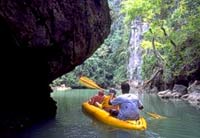 The entrances to many of the sea caves are often small and disappear at
high tide.
The entrances to many of the sea caves are often small and disappear at
high tide.
The Hongs, or "rooms" of Phang Nga Bay and Krabi are
collapsed cave systems open to the sky. They are filled with jungle flora
and fauna and often accessible only through the sea caves at low tide
in tough, purpose-designed inflatable canoes. Each Hong tends to have
its own distinct character.
These systems of caves and hongs were created by the constant moving
force of both fresh and salt water. Percolation created small caves which
in time became collapsed caverns and eroded into open air lagoons. Salt
water tidal action has worked against the fault lines to eat into the
islands and has formed caves. The fact that caves are found at different
heights is testimony to the presence of different sea levels since the
last ice age. This fresh water-salt water combination has created some
unique effects, such as intensely vertical cliffs, and tidal naps or overhangs
inside the lagoons.
The peak season on the west coast of Thailand, including Phuket,
is from November to April, when the sun is shining and there are no strong
winds. Phang Nga Bay, protected by high-rising limestone towers and in
the wind shadow of Phuket Island, offers calm water for ten months of
the year. Even during the southeast monsoon, which is the rainy season
on the western coast of Thailand, the islands and hongs of Phang Nga often
assume an unearthly beauty, especially when it rains, then, inside the
caves, the stalactites sparkle even more. 
Snorkeling
Snorkeling is a simple sport, which allows
even the beginner to glimpse at the incredible undersea world with very
little risk, expensive equipment or long-term planning and preparation.
All that is needed are fins and a mask.
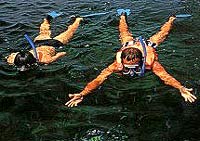 It
is quite easy to become totally fascinated by the submarine world
and forget about the climatic conditions overhead: to avoid a nasty sunburn,
it is recommended that you wear at least a T-shirt and use lots of water-resistant
sun block. It
is quite easy to become totally fascinated by the submarine world
and forget about the climatic conditions overhead: to avoid a nasty sunburn,
it is recommended that you wear at least a T-shirt and use lots of water-resistant
sun block.
Phuket and the entire southern coastal region have lots of shallow
water above coral reefs offering excellent snorkeling conditions. The
sunlit, tropical waters display their incredible colors very well and
many of the exotic marine creatures inhabiting these reefs can be seen
merely by diving down from the surface with a mask and snorkel. 
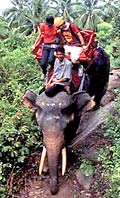 Jungle
and Elephant Trekking Jungle
and Elephant Trekking
Phuket Island itself still has one sizable
tract of virgin rain forest, as well as lots more secondary tropical forest
growth. On the neighboring mainland, Khao Sok National Park offers extensive
forests, rivers, an enormous lake, caves and fascinating flora and fauna,
including a few wild tigers that still inhabit the remoter areas.
Jungle trekking makes an excellent option in the summer season
from May to October, when the forests are at their greenest and the rivers
are high enough for exciting rafting or canoeing trips.
When visiting Thailand don't miss the chance to ride an elephant in one
of Phuket's forested areas. 
Thai Boxing
Thai Boxing or Muay Thai, as the locals call
it, is the traditional martial art of Thailand and wherever it is practiced,
it becomes a gambling event as well. The program for a fighting evening
in a boxing hall like at Saphan Hin Stadium on Phuket consists normally
of no fewer than eight fights, with the fifth fight as the main event.
Show boxing and training fights can be seen daily at the Vegas Boxing
on the top end of Soi Bangla in Patong Beach; entry is free.
The history of Muay Thai goes back as long as Thai culture itself,
around 2.000 years. It evolved from a military code named Chupasart, which
called for all able bodied people to be fully prepared to come to the
aid of their leaders. 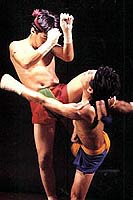 Thus Muay Thai was born.
Thus Muay Thai was born.
In the 16th century, during the reign of King Naresuan the Great,
Muay Thai was introduced as part of the training for foot soldiers. Many
of the battles in these times were settled by soldiers in hand-to-hand
combat and Muay Thai reflects this use.
Up to the present day, tradition continues to play an important
part in the sport of Thai Boxing and no woman is ever allowed to step
into the canvas ring for fear that her influence will destroy the strength
and skill of the boxers. The contestants also wear a charm, a small Buddha
or even a magic amulet on their bodies. This is usually inserted in the
thick cord worn around one or both upper arms and may be kept on during
the fight.
Before every match, the two fighters dance around the ring to a
special kind of music, called the Raam Muay. It is intended to honor and
pay respect to the boxers trainer, his religion, family, sport and the
fighting spirits. Gamblers and spectators say, that they can tell how
a fighter will do in the ring simply by watching how he performs the Raam
Muay.
After a short praying ritual, the fight starts and the music in
the background changes tempo, following the mood of the evening. During
each round, the music will increase in volume and speed to encourage the
boxers to fight. This, coupled with the frenzied yells of the supporters,
makes even the most mundane fight a thrilling event.
At once a sport and a means of self-defense, Thai Boxing differs
dramatically from the western form in that the fighters are free to use
almost every part of their body except the head as a weapon. The feet
are the deadliest and to watch a fighter use them with skill is like observing
a graceful dance, enhanced by the traditional music played throughout
the event. 
|
